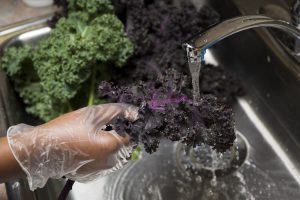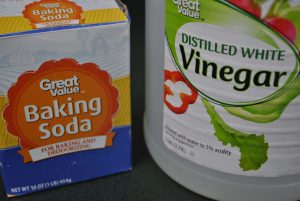
by Dorothy C. Lee | Mar 3, 2020
Spring showers not only bring flowers, but beautiful fresh produce from the garden.
March in National Nutrition Month. Celebrate with nutritious delicious GREENS.

Be sure to carefully wash greens before preparing to ensure a safe and delicious product. (Photo source: Tyler Jones, UF/IFAS)
The dark leafy vegetable we refer to as “greens” range from earthy to peppery in flavor. Collard greens, mustard greens, turnip greens, and kale are often grouped together because of their texture, pronounced flavor, and general uses. They actually come from several vegetable families. In general, these tart greens are cooked before eating. The season for some varieties peak November through March.
Choose leafy greens with fresh full leaves. Avoid greens that are brown, yellow spotted, wilted, or have slimy leaves. Wash greens before use. Cut stems from leafy greens before cooking. Sauté collard greens with garlic, onions, and tomatoes a little bit of olive oil. Simmer greens in low-sodium chicken broth until greens are wilted and tender. Store greens in a plastic bag in the refrigerator for two to five days.
NUTRITION TIPS: A 1/4 cup of cooked greens is about the size of one cupped handful.
Beans and Greens
1 can white kidney beans or cannellini beans rinsed and drained
1 tablespoon olive oil
1/2 cup diced onion
2 cloves garlic, minced
2 pounds fresh kale, stemmed and chopped into large pieces
Salt and pepper to taste
Sauté onion and garlic in olive oil. Add greens to the skillet. Sprinkle with 2 tablespoon of water. Cook, tossing often, until greens are bright green and slightly wilted. Remove from heat. Drain and heat beans and add to green mixture. Toss mixture, season and serve. Serves four; 1 cup serving
Savory Greens
3 cups water
1/4 pound skinless turkey breast
1/2 cup chopped onions
2 cloves garlic, crushed
1/4 teaspoon cayenne pepper
1/4 teaspoon ground cloves
1/2 teaspoon dried thyme
1 green ground ginger
2 pounds mixed greens (collards, turnips, mustard, and kale)
Place all ingredients except greens into large pot and bring to a boil. Wash greens and remove stems. Chop greens into small pieces and add to stock. Cook 20 to 30 minutes until tender. Serves six; 1 cup serving
NUTRITION INFORMATION: Cooked greens are excellent sources of Vitamins A, C, K, and Calcium.
AVAILABLE FRESH: March – June & October – December
To learn about fresh Florida greens, please read our fact sheet: Panhandle Produce Pointers – Greens.
For more delicious produce preparation tips, please visit: http://www.panhandleproducepointers.com.
by Samantha Kennedy | Apr 10, 2018
Many of today’s commercial cleaners are petroleum-based, which may have harmful effects on human and environmental health. But have no fear! On the market today are many wonderful “green” cleaning products that are planet- (and you-) friendly and can be found alongside their more conventional cousins in the cleaning aisle. These products are non-toxic, biodegradable, non-petroleum-based, and are just as effective at getting rid of grime.

Two common household products used in homemade cleaners are vinegar and baking soda. Photo credit: Samantha Kennedy
They do, however, tend to be more expensive. If spending extra money isn’t your thing, you can still clean green” by taking advantage of a few everyday products you probably have in your pantry right now.
White vinegar and baking soda are two of the most effective cleaning products out there and cost just a fraction of what commercial cleaning products cost. Add a little warm water to either of these products and you have created a solution that can clean just about everything, from tile floors to coffee-stained mugs to sinks and showers.
Another great natural and inexpensive cleaning agent is borax. Found in the laundry aisle, it is great as an all-purpose cleaner when mixed with water and can be used on floors, countertops, sinks, and toilets. It is nonabrasive, has no toxic fumes, and is safe for the environment. Borax also doubles as a safe insecticide, by slowly poisoning ants, cockroaches, silverfish, and termites to death.
Other common household products that make great cleaners are salt, lemon juice, and rubbing alcohol. Hot water mixed with salt makes an excellent drain deodorizer. Lemon juice makes a terrific mild bleaching agent and air freshener. Rubbing alcohol makes a great sanitizer for countertops. It is also good for cleaning minor wounds and will kill those annoying ghost ants (and others) that often try to make a home in your kitchen.
Making your own household cleaners is safer, healthier, and less expensive. For some quick and easy cleaner recipes, please read “Homemade Household Cleaners.”
For more information about this and other Family and Consumer Sciences topics, please contact Samantha Kennedy at 850.926.3931 or skennedy@ufl.edu.

by Ricki McWilliams | Dec 11, 2014
 Being sick during the holiday season is no fun. Did you know the flu is not the only thing that can have you feeling under the weather? The Centers for Disease Control and Prevention (CDC) estimate that each year roughly 1 in 6 Americans (or 48 million people) get sick, 128,000 are hospitalized, and 3,000 die of foodborne diseases (CDC, 2014). This holiday season, UF/IFAS Extension Agents will be available to help keep you and the ones you care about safe by reminding you of the United States Department of Agriculture ‘s four steps to safer food handling this holiday season:
Being sick during the holiday season is no fun. Did you know the flu is not the only thing that can have you feeling under the weather? The Centers for Disease Control and Prevention (CDC) estimate that each year roughly 1 in 6 Americans (or 48 million people) get sick, 128,000 are hospitalized, and 3,000 die of foodborne diseases (CDC, 2014). This holiday season, UF/IFAS Extension Agents will be available to help keep you and the ones you care about safe by reminding you of the United States Department of Agriculture ‘s four steps to safer food handling this holiday season:
- Wash your hands and your cooking surfaces before you start, when you will touch different foods, and after you finish preparing a dish.
- Separate cooked foods and ready-to-eat foods from foods that still need to be prepared.
- Always cook and reheat your foods to above 140 degrees Fahrenheit.
- Chill your leftovers. Don’t let your dishes sit out without refrigerating or keeping them heated. Throw out foods that have been between 40 degrees and 140 degrees Fahrenheit for more than 2 hours.
Have a question that is not related to food safety, like:
- How do I make a brine for my turkey?
- I ran out of eggs – is there a substitute?
- I couldn’t find any buttermilk. What do I do?
…Don’t worry – call the UF/IFAS Extension Northwest District Family and Consumer Sciences (FCS) HOLIDAY FOOD HOTLINE. Northwest District FCS agents will be available 8am – 8pm CST/9 am – 9pm EST by calling 850-888-2412 (December 15 – January 1) to assist you with food preparation, food safety, or any other kitchen concerns you may have.
The best part is you can always count on UF/IFAS Extension to provide you with research-based information!
Holiday Food Hotline
850-888-2412
References:
Centers for Disease Control and Prevention (2014). “Estimates of Foodborne Illness in the United States” retrieved December 11, 2014 from http://www.cdc.gov/foodborneburden/
United States Department of Agriculture (2014). “Check Your Steps: Food Safe Families” retrieved December 11, 2014 from http://www.fsis.usda.gov/wps/portal/fsis/topics/food-safety-education/featured-campaign





